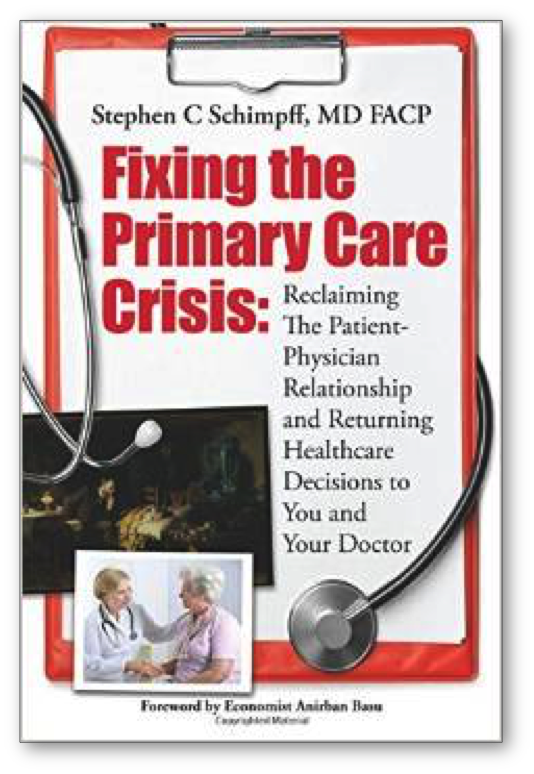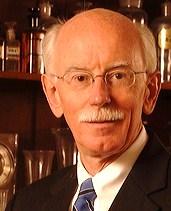Fixing the Primary Care Crisis
 There’s a primary care crisis. As I keep reminding people, Americans spend twice as much as other countries on health care yet still live sicker and die younger, according to the World Health Organization. At $3 trillion/year, that’s about 18% of the nation’s GDP, and it’s not sustainable, especially as our nation’s baby boomers approach retirement age and start needing more medical care in their later years.
There’s a primary care crisis. As I keep reminding people, Americans spend twice as much as other countries on health care yet still live sicker and die younger, according to the World Health Organization. At $3 trillion/year, that’s about 18% of the nation’s GDP, and it’s not sustainable, especially as our nation’s baby boomers approach retirement age and start needing more medical care in their later years.
I’ve known Dr. Stephen C Schimpff (electronically) for years and have published several of his articles here on mHealthTalk. I’m happy today to promote his controversial new book, Fixing The Primary Care Crisis: Reclaiming the Patient-Doctor Relationship and Returning Healthcare Decisions to You and Your Doctor. ($3.95 for the e-book and $14.95 for the print edition)
Dr. Schimpff begins his book with an overview of what primary care is and is not, why it’s in crisis, and why the American medical care delivery system is so badly dysfunctional. He then explores the concepts of integrative medicine, trust and the all-important issue of healing.
A Nation in Search of Healthcare Solutions
From the Forward: “How did it come to this? How is it possible for a nation that is the world’s wealthiest and most powerful, with reams of data on hand and with an abundance of MBAs to analyze them, to produce arguably the advanced world’s most inefficient healthcare system?”
Too many visits means not enough time per patient.
Dr. Schimpff reminds us that Primary care physicians (PCPs) today earn less than they did forty years ago in inflation-adjusted dollars, but they see about twice as many patients per day. They’ve been forced by an insurance payment system into scheduling more patient visits per day than they once did or should, leaving less time per visit, and that’s at the core of the crisis he describes.
Here’s an example, from the Preface:
“Susan is 56, married, insured, a successful professional and is in generally good health. She began to have a strange sensation in her right chest, which she described as a shooting sensation almost electrical and vibrational in nature, and which stretches from high up in her right chest down as a narrow line over her rib cage and onto her abdomen. It seems to be immediately under the skin, starts intermittently and ends at no set time. She visited her primary care physician (PCP) and gave this description, adding that she was concerned that it might be her heart. The doctor asked additional questions and did an exam and electrocardiogram. All were normal except for the description of the sensation Susan was feeling.
Her PCP was now running out of time for the fifteen-minute visit. Here was a fork in the road with two paths. Given that Susan indicated a concern about her heart, the PCP chose the path to send her to a cardiologist for further evaluation. The cardiologist did a history and exam related to her heart and found nothing abnormal but suggested a stress test and echocardiogram. Both were normal. The cardiologist said it was not Susan’s heart causing the problem, but since the sensation crossed over to the upper abdomen, maybe it would be a good idea to see a gastroenterologist. The GI doctor also did a history and exam and found nothing. Nevertheless, among many other tests, he ordered a CT scan of the abdomen. All was normal except for a small cyst in her uterus. The radiologist read it as benign cyst but – feeling the need to be cautious – recommended Susan visit a gynecologist. The gynecologist also said it looked benign, but to be on the safe side, she could remove it laparoscopically. Susan would be “out of the hospital the same day and feeling fine in a day or so.” The cyst was just that, a benign cyst.
Susan still had the strange sensation in her chest and no one had found an answer for her. But given it seemed to have an electrical feeling, the gynecologist suggested that it could be a nerve issue. So she visited a neurologist who found nothing, commenting that the nerves run around the chest, not up and down.
Susan’s story illustrates the problem so common today in primary care. The primary care physician should be the backbone of the American healthcare system. But primary care is in crisis – a very serious crisis. In this story, the PCP did not truly listen to his patient. He did not stop and think the issue out carefully. He had no time to delve into what might actually cause Susan’s pain since there was a waiting room full of patients and he needed to see about 25 that day. So instead, he took the easier path and referred the patient to a cardiologist since this seemed like a logical choice. Had he followed the other side of the fork in the road, listened long enough and then thought about it, he would have concluded that Susan was hypersensitive to minor, albeit real, sensations. He would have offered reassurance that it did not represent a life-threatening ailment. He would have said that it was real but of no concern. He might have offered a few weeks of low-dose anti-anxiety medications such as alprazolam (Xanax), offered further reassurance and told her to return in two weeks for a follow-up. At the follow-up, he might have explored the issue producing anxiety or stress in her life – finances, marital relationship, a disruptive child, or an overbearing in-law. What Susan really needed was assistance to overcome her stress, not months of specialist hopping, which was unnecessary, expensive and only increased her stress.
Anxiety and stress are often components associated with a physical symptom, and these can only be addressed with more time to carefully listen and respond with suggestions. But Susan was shipped from doctor to doctor, test to test, and even had an operation with no one really listening enough to figure out her problem. All each specialist could do was say it was not in his or her “organ system” and leave her without a sense of closure. Each said it was not the heart, the stomach or the nerves. And the surgery “went fine,” but she still had the unpleasant sensation. All of this resulted in far less than adequate medical care and cost a king’s ransom. That is what happens today. All that was needed was for the PCP to spend some more time – time to listen, then to think and then to counsel. That’s not expensive at all.
Susan’s story and her travails with the medical system illustrate how deep the problem goes. Her journey highlights the issues that drove me to research and write this book. Multiple other patient vignettes scattered throughout the book will underscore the reality of the crisis – and its impact on all of us. In the process, I will explain how you, as a patient, can receive excellent care at limited expense.”
Fixing the Primary Care Crisis
Dr. Schimpff uses this book to show how to revitalize the patient-doctor relationship and to put decision-making back into the hands of patients and their doctors. To fix to the crisis, he says patients must insist, and doctors must agree to, the needed changes he offers. If Americans want to see better and more-affordable healthcare, the changes discussed in this book must be implemented.
Abbreviated Table of Contents
PART I BACK TO BASICS: PRIMARY CARE
- Chapter 1 The Primary Problem with Primary Care
- Chapter 2 The Paradox in American Healthcare
- Chapter 3 Why Primary Care Matters
- Chapter 4 Bringing Back the Human Side of Healing
- Chapter 5 Not All Ills Can Be Cured with a Pill: The Doctor as a Healer
PART II FACTS, FRUSTRATIONS, CONSUMERISM AND GOVERNMENT INCURSIONS
- Chapter 6 Primary Care: Just the Facts (and Figures)
- Chapter 7 Teams are Important for Healthcare: Nurse Practitioners, Physician Assistants and Primary Care Physicians
- Chapter 8 The Future is Now: Accountable Care Organizations, the Medical Home and Population Health
- Chapter 9 Why Primary Care Physicians are so Fed Up (and why you should care)
- Chapter 10 Why Patients are Losing Patience
PART III THE CHANGING NATURE OF ILLNESSES: FROM ACUTE TO CHRONIC
- Chapter 11 The Impact of Chronic Diseases
- Chapter 12 Rethinking Care for the Chronically Ill
PART IV THE TRANSFORMATION OF PRIMARY CARE THROUGH INNOVATKION
- Chapter 13 Putting Healthcare Decisions Back Where they Belong – in the Hands of You and Your Doctor
- Chapter 14 Innovators: Primary Care Physicians Who Got it Right
- Chapter 15 Innovators: Insurance Providers Who Got it Right
- Chapter 16 Innovators: Primary Care-based Organizations that are Improving Care
- Chapter 17 Innovators: Employers Who Got it Right
- Chapter 18 Retail Primary Care: Readily Available and Inexpensive but not Relationship Care
PART V FINDING A CURE
- Chapter 19 Getting the Best Possible Healthcare
- Chapter 20 The Choice is Yours: A Call to Action
 About the Author
About the Author
Stephen C. Schimpff, MD is the retired Chief Executive Officer of the University of Maryland Medical Center and former chief operating officer of the University Maryland Medical System – today a twelve hospital system – where he taught as profession of medicine and public policy.
He is also the author of The Future of Medicine – Megatrends in Healthcare and The Future of Health Care Delivery- Why It Must Change and How It Will Affect You. Many of the concepts from these books can be found on his blog – http://medicalmegatrends.blogspot.com.


RELATED ARTICLES:
PRIMARY CARE: a Health Care Solution We Can’t Afford To Ignore (Washington Post) — Good to see articles about improving care delivery, and using a focus on wellness to help reduce the need in the first place. (ounce of prevention vs. pound of cure)